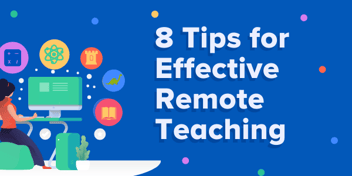Thousands of teachers are making the shift to online digital learning virtually overnight. This is a tricky situation as not all school districts have the same academic expectations about what the remainder of the year should look like, and not all students have equal access to technology at home.
But this is also an opportunity for teachers to grow. The energy usually spent on classroom management can now be redirected to support students in other ways, like personal check-in calls, designing project-based learning units, and experimenting with new media resources.
If you’re making a sudden shift to remote teaching due to the COVID-19 outbreak and aren’t sure where to start, these tips are for you.
1. Show your face often!
It’s been said again and again about social distancing - we’re all social creatures! The psychological impact of being apart from others weighs heavily on many of us, but especially children and adolescents. The World Health Organization even changed their messaging to promote physical distancing, rather than social distancing, in an effort to encourage people to use digital tools to stay connected.
Across the country, teachers are hosting live chats with their students to answer questions about their assignments or even virtual socratic seminars and literature circles. If you’re engaging with your students in live digital formats like these, try to set aside the first minute of every call to let students make funny faces at each other, share a joke, or say hello to their classmates. This will help reduce stress and bring familiar classroom chit-chat to the virtual format.
If you’re not going live, try recording a short video of yourself at least once a week. Use this opportunity to be a friendly face, provide updates to your class, and continuously invite students to engage with you over email.
2. Up your emoji game
You’re not in the classroom anymore, and digital expression is key. Social norms and language function differently online, with entirely new sets of grammar rules for posts, instant messages, and email.
Right now, many students are probably feeling a lack of self expression and are relying even more on digital language and media to be themselves. Be flexible in light of this stress and make space for students to have a digital voice and personality. If you’re using a virtual classroom space or forum, consider creating a thread for students to share music, movie recommendations, or what books they’re reading. Don’t dock points if students want to include emojis or gifs in casual chats. If the dialogue is outside of a formal paper or writing assignment, it’s a good time to be flexible.
3. Embrace the medium
Maybe you haven’t had time to explore adding media to your lessons until now. The digital medium will enable the use of seemingly infinite options of new media for learning. These can range from live interactive quizzes, classroom polls, videos, music, and games.
Incorporating media can help the virtual classroom come alive and feel dynamic. Try kicking off the week with a funny or controversial poll (which Hogwarts House would you be in?) and end the week with a favorite video or trivia game.
Throughout your lessons over the next few months, try sharing videos from Boclips for Teachers with your students on Google Classroom. Our new feature allows you to share entire collections with students, which is perfect for assigning long-form content like this documentary about home waste and the environment.
<<To discover more resources for remote learning, check out our free toolkit with videos, tutorials, tip and more>>
4. Collaborate with colleagues
You tell your students every day that developing new skills requires practice. The same is true for you, your colleagues, and everyone else switching to remote work. If you can, spend some time with your fellow teachers simulating lessons or meetings before going live, or just schedule informal chats to pass lesson ideas back and forth.
Consider creating a chat group to share links to helpful resources, like apps, websites, videos, or worksheets. If your colleagues haven't been able to check it out yet, share our Remote Learning Resources Kit with a collection of videos, strategy sheets, and guides—all curated to support teachers as they transition to remote learning.
5. Work with small groups
Some of your students may be going through difficult times at home. They could be responsible for looking after a younger sibling, caring for an ill parent, or home alone. If possible, try to make time to check in with your students in smaller groups to provide them some much-needed attention and care.
You could consider 15 or 20 minute meetings with small groups of five or ten students to answer homework questions, or join in on literature circle conversations. Informal chats work too, especially if you want to show them something - like a fun experiment from Veritasium or steps in an equation.
Some teachers are going the extra mile and calling students individually to check in. If this isn’t an option, a personalized email or physical letter in the mail can go a long way in making sure no student feels left out of their classroom community.
6. Experiment with new tools
A major feature of Boclips for Teachers is the ability to share videos directly into Google Classroom. Learning management systems like Google Classroom are great for teachers because you can have your students complete assignments and notes on paper, then have them upload pictures of it to your virtual classroom. This is excellent for math teachers and makes it easy to see problem solving and calculation processes from students.
Other tools you might find useful are Microsoft Whiteboard, Zoom, document camera programs, or using a stylus to mark PDFs.
7. Practice flexibility
Here’s the hard truth: your students will not be able to accomplish the same amount of work as they do when they’re at school. There will be an adjustment period and until students are comfortable and familiar with the new format, it’s important to be flexible.
This doesn’t mean that your students can’t be successful as remote learners - indeed, some might achieve more at home! - but there are so many variables at work during a time of crisis and sudden change that will affect both your and your student’s ability to work.
Take it easy, assign lighter loads, and spend time reviewing work and building bonds with your students. There are many socioeconomic factors that teachers may be suspicious of, but ultimately the home life of most students will remain invisible.
8. Model a culture of feedback
Soliciting feedback from students might be unfamiliar territory for many teachers, but it’s useful in making the most of remote teaching. Ask students and parents things are going, and ask often—maybe every week—and keep track of their answers. Ask if they have any ideas to make remote learning easier, more efficient, or if the lessons could be made clearer with parent instructions.
If you’re doing live lessons or chats, consider inviting a colleague or two to sit in and listen. Their feedback may prove to be invaluable in improving your virtual classroom culture or reshaping expectations.
Bree Fabig
Bree has experience in multicultural and multilingual classrooms in the US, Japan, and Nepal and has taught primary, ESL, SAT prep, and secondary language arts.
- #Video in Digital Learning
- #Classroom
- #Educational Videos
- #Video Content Partners
- #Tips for Using Video
- #Boclips for Publishers
- #Issues in Education
- #Educational Videos by Subject Area
- #News and Announcements
- #Events & Holidays
- #Video and Teaching Tools
- #Teaching Methodologies
- #Education Videos
- #Video and Digital Literacy
- #Short Educational Videos
- #Instructional Design
- #Multimodal Learning
- #Video and Student Safety
- #Accessibility in Education
-3.png?width=390&height=223&name=Untitled%20design%20(2)-3.png)


.png?width=1152&height=660&name=Copy%20of%20Untitled%20Design%20(1).png)




